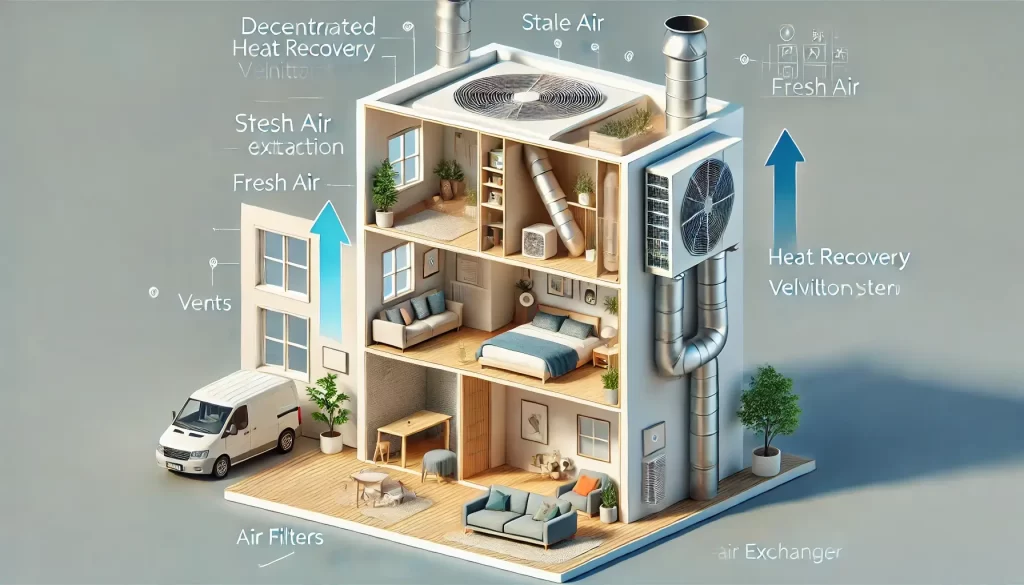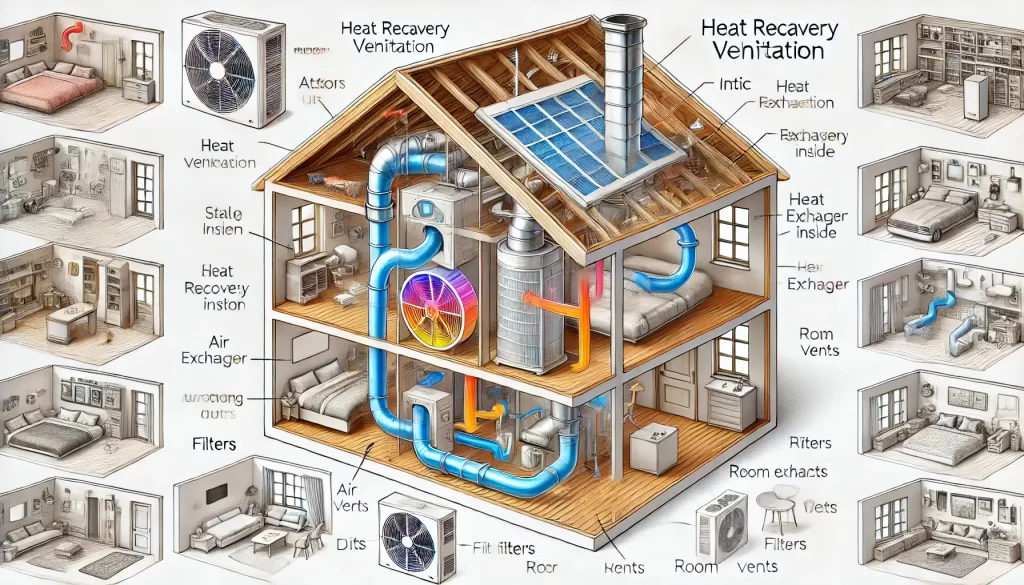A heat recovery ventilation system (HRV) is an essential solution for maintaining air quality and energy efficiency in homes, especially in climates like Saudi Arabia. This system helps reduce energy consumption by recycling heat while ensuring a constant supply of fresh, filtered air. In this article, we’ll explore the best heat recovery ventilation systems, their benefits, and how they work, making it easier to choose the right system for your home.
What is a Heat Recovery Ventilation System?
A heat recovery ventilation system works by extracting stale air from the home and replacing it with fresh air. It recovers heat from the outgoing air and transfers it to the incoming air without mixing the two air streams. This way, the home remains well-ventilated and energy-efficient.
How Do Heat Recovery Ventilation Systems Work?
- The system is usually installed in the attic or roof space.
- Stale air is extracted from the home through ducts.
- Fresh air is drawn from outside and passed through a heat exchanger.
- The heat from the stale air is transferred to the fresh air, which is then circulated through the home.
- Both airflows remain separate to avoid contamination.
Key Benefits of a Heat Recovery Ventilation System

Installing a heat recovery system offers numerous benefits, particularly in hot climates like Saudi Arabia, where maintaining indoor air quality without losing energy is crucial. Here are some of the main advantages:
Energy Efficiency
- Recovers up to 95% of the heat from the outgoing air.
- Reduces the need for heating or cooling systems to work harder.
- Potentially save up to 30% on energy bills.
Improved Air Quality
- Removes pollutants, dust, and pollen from the incoming air.
- Reduces moisture, condensation, and odours.
- Helps prevent mold growth by managing humidity levels.
Health Benefits
- Improves indoor air quality, which is essential for those suffering from allergies or asthma.
- Reduces the risk of respiratory problems caused by poor ventilation.
- Ensures a constant supply of clean, fresh air throughout the home.
Environmentally Friendly
- Reduces the home’s overall carbon footprint.
- Helps in achieving energy efficiency ratings for new constructions.
Types of Heat Recovery Ventilation Systems
There are two main types of heat recovery ventilation systems available in Saudi Arabia, depending on your home’s size and layout:
Centralized Heat Recovery Systems
These systems are suitable for medium to large homes and involve installing ductwork throughout the property. They provide whole-house ventilation and are typically installed in the attic or roof space.
Advantages:
- Ideal for new builds or larger homes.
- Offers full control over air circulation and temperature.
Disadvantages:
- Requires professional installation.
- Higher initial cost but provides long-term energy savings.
Decentralized Heat Recovery Systems
These systems are perfect for smaller spaces or single rooms, such as apartments or individual areas in a home. They don’t require extensive ductwork and are easier to install.
Advantages:
- Easier and cheaper to install.
- Ideal for retrofitting older buildings.
Disadvantages:
- Limited to specific rooms.
- It may require multiple units for larger homes.

Heat Recovery Ventilation System Costs
The cost of a heat recovery ventilation system depends on several factors, including the type of system, the size of the home, and installation requirements. In Saudi Arabia, prices, including installation, can range from SAR 7,500 to SAR 20,000.
Factors affecting cost:
- Size and layout of the property.
- Ductwork requirements for centralized systems.
- The complexity of installation (e.g., retrofitting an older home).
Pros and Cons of a Heat Recovery Ventilation System
Pros:
- Energy savings: Significant reduction in heating and cooling costs.
- Improved air quality: Filters out pollutants, ensuring a healthier indoor environment.
- Reduced condensation: Helps prevent mould and dampness in homes.
- Environmentally friendly: Lower carbon emissions and energy usage.
Cons:
- Initial cost: Higher upfront investment, though long-term savings often offset this.
- Regular maintenance: Filters need to be changed annually to ensure efficiency.
- It is not ideal for poorly insulated homes; it works best in airtight, well-insulated buildings.
Choosing the Best Heat Recovery Ventilation System for Your Home
When selecting the best heat recovery ventilation system for your home in Saudi Arabia, consider the following:
- Home size: Centralized systems are better for larger homes, while decentralized units work for smaller spaces.
- Energy efficiency: Look for systems with high heat recovery efficiency (above 90%).
- Noise levels: Choose quieter models, especially if the system will be installed in living areas.
- Filter quality: Opt for systems with high-grade filters that can remove fine particles like dust and pollen.
- Professional installation: Ensure that certified professionals install the system to optimize performance.
How to Maintain a Heat Recovery Ventilation System
Maintenance of these systems is simple and usually involves:
- Changing the filters once or twice a year.
- Regularly checking the system for blockages.
- Ensuring the ducts remain clean and unobstructed.
Proper maintenance ensures that the system continues to operate efficiently, providing fresh, clean air while reducing energy consumption.
Conclusion
Investing in the best heat recovery ventilation system is a smart decision for homes in Saudi Arabia. These systems not only improve indoor air quality but also significantly reduce energy consumption, leading to lower utility bills. Whether you choose a centralized or decentralised system, the benefits of healthier air, energy efficiency, and reduced environmental impact make heat recovery ventilation systems an excellent addition to any home.
For optimal results, consult with a professional to select and install the system that best meets your needs, ensuring long-term savings and comfort for you and your family.
